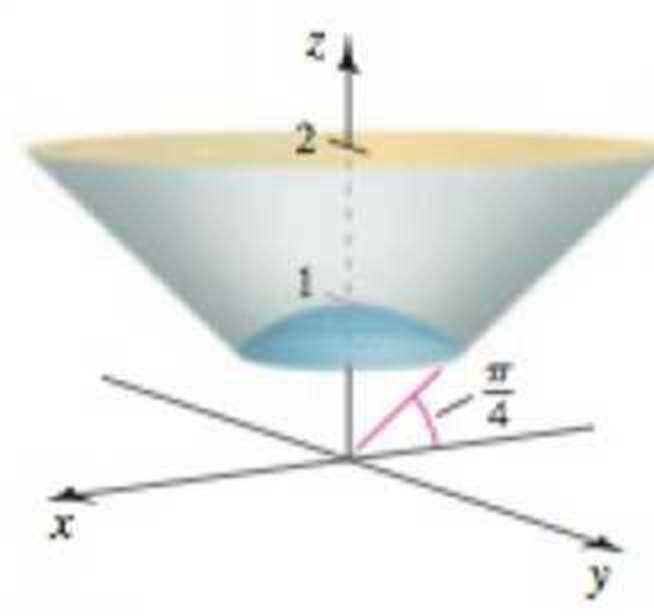
44.

Want to see the full answer?
Check out a sample textbook solution
Chapter 13 Solutions
Calculus: Early Transcendentals, 2nd Edition
Additional Math Textbook Solutions
Basic Business Statistics, Student Value Edition
A First Course in Probability (10th Edition)
Thinking Mathematically (6th Edition)
Calculus: Early Transcendentals (2nd Edition)
A Problem Solving Approach To Mathematics For Elementary School Teachers (13th Edition)
University Calculus: Early Transcendentals (4th Edition)
- Example: If ƒ (x + 2π) = ƒ (x), find the Fourier expansion f(x) = eax in the interval [−π,π]arrow_forwardExample: If ƒ (x + 2π) = ƒ (x), find the Fourier expansion f(x) = eax in the interval [−π,π]arrow_forwardPlease can you give detailed steps on how the solutions change from complex form to real form. Thanks.arrow_forward
- Examples: Solve the following differential equation using Laplace transform (e) ty"-ty+y=0 with y(0) = 0, and y'(0) = 1arrow_forwardExamples: Solve the following differential equation using Laplace transform (a) y" +2y+y=t with y(0) = 0, and y'(0) = 1arrow_forwardπ 25. If lies in the interval <0arrow_forward21/solve the following differential equation Using laplace transform y₁ =-y, Y₁(0)=1 y' = Y Y₂(0)=0 2 21 Solve the following equations: dy 1- dt + 2y + = ydt 2 cost, y(0) = 1 2 2- y(t) = ±² + (yet) sin (t-u) du Q3: Answer the following: 1- L [Log Sa] (5²+9²) 2- L1 [Log (Cos²y1] 0-25 3-L-1 [ -] 4- (5+1) 3 L (ezt sin3t) e-s 5- L-1 ( 너 (0) 5² +5arrow_forwardLESSON MATHEMATICS ACTIVITIES 1.3 DECIMALS 1. Josh used itres of ster during an Integrahed Express the ami remained DATE b) 14.07 2. Express 0.5 as a fraction in its simplest form or e) 327.034 7. Write the number form is e) 5.11x 10 ese standard 3. Express 0.145 os simplest form fraction in its b) 2.03x102 4. In August 2022, the cost of a litre of petrol was Sh 159.25. How much did kipchoge pay for two litres? c) 6.3x103 5. A doctor prescribed 12.5 ml of a dr to a patient. Express the drug prescribed in litres to two significant figures 8. Work out: a) 2.05 5.2-1.8 rite each of the following in stand- ds form 0039 b)3.6 2.8 (2.8+0arrow_forwardRK 119 43 Previous Problem University at Buffalo Problem List Next Problem Match the surfaces (a) - (f) below with the contour diagrams (1) - (6) below those. (a) Surface (a) matches contour 5 V V (b) Surface (b) matches contour 2 V (c) Surface (c) matches contour 1 (d) Surface (d) matches contour 6 V (e) Surface (e) matches contour 4 V (f) Surface (f) matches contour 3 V (4) (1) -0.25 (a) (b) (c) (d) (e) y y 2.5 0.5 1.5 1.5 1.5 y .3 0.25 OC 0.25 -0.25 (2) X 1.5 ZI (f) y 0.01 0.01 (3) ☑ X 0.01 0.01 0.2 0.2 (5) 0 x 0.5 (6) 0.25 X X 0.25 0.5arrow_forwardarrow_back_iosSEE MORE QUESTIONSarrow_forward_ios
 Calculus: Early TranscendentalsCalculusISBN:9781285741550Author:James StewartPublisher:Cengage Learning
Calculus: Early TranscendentalsCalculusISBN:9781285741550Author:James StewartPublisher:Cengage Learning Thomas' Calculus (14th Edition)CalculusISBN:9780134438986Author:Joel R. Hass, Christopher E. Heil, Maurice D. WeirPublisher:PEARSON
Thomas' Calculus (14th Edition)CalculusISBN:9780134438986Author:Joel R. Hass, Christopher E. Heil, Maurice D. WeirPublisher:PEARSON Calculus: Early Transcendentals (3rd Edition)CalculusISBN:9780134763644Author:William L. Briggs, Lyle Cochran, Bernard Gillett, Eric SchulzPublisher:PEARSON
Calculus: Early Transcendentals (3rd Edition)CalculusISBN:9780134763644Author:William L. Briggs, Lyle Cochran, Bernard Gillett, Eric SchulzPublisher:PEARSON Calculus: Early TranscendentalsCalculusISBN:9781319050740Author:Jon Rogawski, Colin Adams, Robert FranzosaPublisher:W. H. Freeman
Calculus: Early TranscendentalsCalculusISBN:9781319050740Author:Jon Rogawski, Colin Adams, Robert FranzosaPublisher:W. H. Freeman
 Calculus: Early Transcendental FunctionsCalculusISBN:9781337552516Author:Ron Larson, Bruce H. EdwardsPublisher:Cengage Learning
Calculus: Early Transcendental FunctionsCalculusISBN:9781337552516Author:Ron Larson, Bruce H. EdwardsPublisher:Cengage Learning





